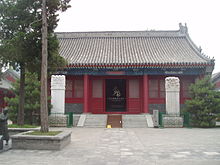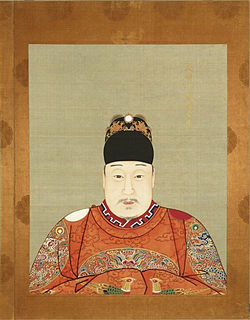
Jilin, is one of the three provinces of Northeast China. Jilin borders North Korea and Russia to the east, Heilongjiang to the north, Liaoning to the south, and Inner Mongolia to the west.
The Zhengyici Peking Opera Theatre, located on a hutong in the Xuanwu District of Beijing, is one of the best-known Beijing opera theatres. It is also one of the oldest wooden theatres in China. Zhengyici means a temple (ci) for Zhengyi Xuantan Laozu (正乙玄坛老祖).
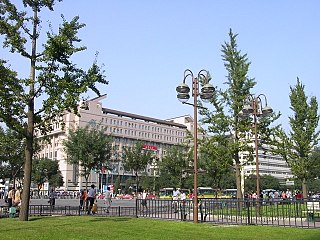
Xicheng District is a district of Beijing. Xicheng District spans 32 square kilometres (12 sq mi), making it the largest portion of the old city, and has 706,691 inhabitants. Its postal code is 100032. Xicheng is subdivided into 15 subdistricts of the city proper of Beijing. The former Xuanwu District was merged into Xicheng on July 2010.
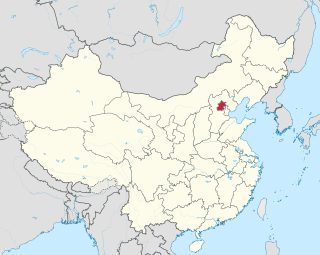
Beijing is a municipality located in North China at the northern tip of the North China Plain, near the meeting point of the Xishan and Yanshan mountain ranges. The city itself lies on flat land that opens to the east and south. The municipality's outlying districts and counties extend into the mountains that surround the city from the southwest to the northeast. The highest peaks are over 2,000 m (6,600 ft).
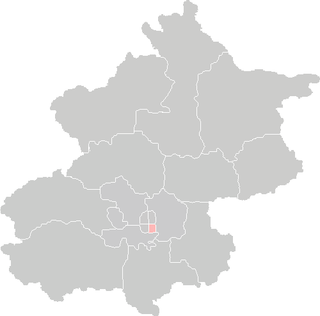
Chongwen District is a former district of Beijing, located relatively southeast to the city center (Tiananmen), and was situated between Yongdingmen and Qianmen. It spanned an area of 16.46 square kilometres (6.36 sq mi). It bordered Dongcheng District to the north, Fengtai District to the south, Chaoyang District to the east, and Xuanwu District to the west. It merged into the Dongcheng District in July 2010.
Changchun or Chang Chun may also refer to:
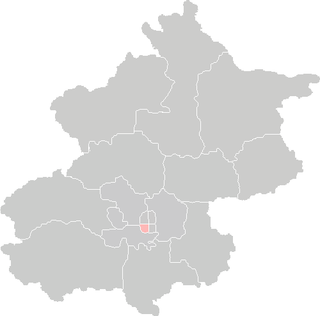
Xuanwu District is a former district of the Municipality of Beijing. It was located southwest to the city center, outside of Xuanwu Gate. The district was merged into Xicheng District in July 2010.

The Niujie Mosque is the oldest mosque in Beijing, China. It was first built in 996 during the Liao Dynasty and was reconstructed as well as enlarged under the Kangxi Emperor of the Qing Dynasty.

The Zhihua Temple is a Ming dynasty-era Buddhist temple in Beijing, China. It is located in the Lumicang (禄米仓) hutong, in the Chaoyangmen area of Dongcheng District, within the Second Ring Road to the north of Jinbaojie Street, west of the Yabaolu area. The temple was built in 1443 at the order of Wang Zhen, a powerful eunuch in the Rites Supervising Office of the court of the Zhengtong Emperor.

The Wanshou Temple is a temple located at the Suzhoujie in Haidian District, Beijing. In addition to being a Buddhist temple, the Wanshou Temple also houses the Beijing Art Museum (北京艺术博物馆/北京藝術博物館).

Temple of Agriculture or Altar of Agriculture is a historic site in Xuanwu District of Beijing, China, and located near the Temple of Heaven.

Xuanwu District is one of 11 districts of Nanjing, the capital of Jiangsu province, China. Xuanwu District is an urban centre located in the north-eastern part of Nanjing. It is the site of the Nanjing Municipal Government.

Xuanwu Lake is located in Xuanwu District in the central-northeast part of Nanjing, Jiangsu. It is near the Nanjing Railway Station and Ji Ming Temple. Five islands within the lake are interconnected by arched bridges. Within the park are temples, pagodas, pavilions, gardens, teahouses, restaurants, entertainment venues, a small zoo, and other attractions. Its main entrance is the Xuanwu Gate.

The Beijing Liao and Jin Dynasty City Wall Museum is a museum built over the ruins of Beijing's Liao and Jin dynasty (1115–1234) city wall. The museum is located in Yulin neighborhood, near Youanmenwai in Fengtai District of southwestern Beijing, near the north bank of the Liangshui River.
Wu Chengzhen is the first Chinese woman to be ordained as a fangzhang (abbess) in the history of Taoism.

The Banruo Temple, also pronounced Bore, is a Buddhist temple located in Nanguan District of Changchun, Jilin, China.

Dizang Temple is a Buddhist temple located in Nanguan District of Changchun, Jilin, China. Dizang Temple is named after Kṣitigarbha, one of the "Four Bodhisattva in Chinese Buddhism". The temple is a Bhikkhuni temple.


